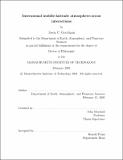| dc.contributor.advisor | John Marshall. | en_US |
| dc.contributor.author | Goodman, Jason (Jason Curtis), 1973- | en_US |
| dc.contributor.other | Massachusetts Institute of Technology. Dept. of Earth, Atmospheric, and Planetary Sciences. | en_US |
| dc.date.accessioned | 2005-05-19T14:33:45Z | |
| dc.date.available | 2005-05-19T14:33:45Z | |
| dc.date.copyright | 2001 | en_US |
| dc.date.issued | 2001 | en_US |
| dc.identifier.uri | http://hdl.handle.net/1721.1/16779 | |
| dc.description | Thesis (Ph. D.)--Massachusetts Institute of Technology, Dept. of Earth, Atmospheric, and Planetary Sciences, 2001. | en_US |
| dc.description | Includes bibliographical references (p. 144-151). | en_US |
| dc.description | This electronic version was submitted by the student author. The certified thesis is available in the Institute Archives and Special Collections. | en_US |
| dc.description.abstract | This thesis discusses the interaction of atmosphere and ocean in midlatitudes on interannual and decadal timescales. We investigate the extent to which mutuallycoupled atmosphere-ocean feedback can explain the observed coupled variability on these timescales, and look for preferred modes of atmospheric response to forcing by sea-surface temperature anomalies. First, we formulate and study a very simple analytical model of the mutual interaction of the middle-latitude atmosphere and ocean. The model is found to support coupled modes in which oceanic baroclinic Rossby waves of decadal period grow through positive coupled feedback between the thermal forcing of the atmosphere induced by associated SST anomalies and the resulting windstress forcing of the ocean. Growth only occurs if the atmospheric response to thermal forcing is equivalent barotropic, with a particular phase relationship with the underlying SST anomalies. The dependence of the growth rate and structure of the modes on the nature of the assumed physics of air-sea interaction is explored, and their possible relation to observed phenomena discussed. We then construct a numerical model with the same physics; this enables us to consider the effects of nontrivial boundary conditions and background flows within the model. We find that the finite fetch of a closed ocean basin reduces growth rate and can lead to decay. However, the coupled mode described above remains the least-damped, and is thus the pattern most easily energized by stochastic forcing. Using a non-uniform atmospheric background flow focuses perturbation energy into particular areas, so that the coupled mode's expression in the atmosphere becomes fixed in space, rather than propagating. This improves the mode's resemblance to observed patterns of variability, such as the North Atlantic Oscillation, which are generally stationary patterns which fluctuate in intensity. The atmospheric component of the coupled mode exists in a balance between Rossby-wave propagation and vorticity advection. This is the same balance as the "neutral vectors" described by Marshall and Molteni (1993). Neutral vectors are the right singular vectors of the linearized atmospheric model's tendency matrix that have the smallest eigenvalues; they are also the patterns that exhibit the largest response to forcing perturbations in the linear model. We explain how the coupled mode arises as the ocean excites atmospheric neutral vectors. Neutral vectors act as pattern-specific amplifiers of ocean SST anomalies. We then proceed to study the neutral vectors of a quasigeostrophic model with realistic mean flow. We find a striking similarity between these patterns and the dominant patterns of variability observed in both the full nonlinear model and in the real world. We provide a mathematical explanation for this connection. Investigation of the "optimal forcing patterns" - the left singular vectors - proves to be less fruitful. The neutral modes have equivalent barotropic vertical structure, but their optimal forcing patterns are baroclinic and seem to be associated with low level heating. But the horizontal patterns of the forcing patterns are not robust, and are sensitive to the form of the inner product used in the SVD analysis. Additionally, applying "optimal" forcing patterns as perturbations to the full nonlinear model does not generate the response suggested by the linear model. | en_US |
| dc.description.statementofresponsibility | by Jason Goodman. | en_US |
| dc.format.extent | 151 p. | en_US |
| dc.format.extent | 2575811 bytes | |
| dc.format.extent | 2575466 bytes | |
| dc.format.mimetype | application/pdf | |
| dc.format.mimetype | application/pdf | |
| dc.language.iso | eng | en_US |
| dc.publisher | Massachusetts Institute of Technology | en_US |
| dc.rights | M.I.T. theses are protected by copyright. They may be viewed from this source for any purpose, but reproduction or distribution in any format is prohibited without written permission. See provided URL for inquiries about permission. | en_US |
| dc.rights.uri | http://dspace.mit.edu/handle/1721.1/7582 | |
| dc.subject | Earth, Atmospheric, and Planetary Sciences. | en_US |
| dc.title | Interannual middle-latitude atmosphere-ocean interactions | en_US |
| dc.type | Thesis | en_US |
| dc.description.degree | Ph.D. | en_US |
| dc.contributor.department | Massachusetts Institute of Technology. Department of Earth, Atmospheric, and Planetary Sciences | |
| dc.identifier.oclc | 49523004 | en_US |
